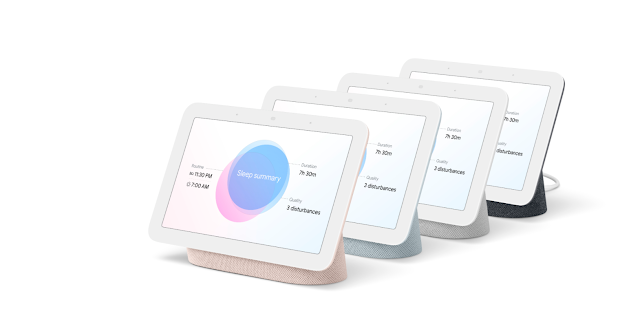Need a better night’s sleep? Meet the new Nest Hub

A little more than two years ago, I was part of the team that created Nest Hub, Google’s first smart display. Since then, we’ve been exploring ways to make these devices even more helpful. We know that people already come to Google for information and tools to help them live healthier, happier lives, and we’ve specifically noticed more and more questions about sleep, exercise and health. So we decided to bring these kinds of solutions to our second-generation Nest Hub, while also improving on the things people already love about it.
The Nest Hub you love, but better
The new Nest Hub’s speaker is based on the same audio technology as Nest Audio and has 50 percent more bass than the original Hub. Fill any room with songs, podcasts or audiobooks from services like YouTube Music, Spotify — or enjoy your favourite TV shows and movies with a subscription from providers like Netflix and Disney+. With Quick Gestures, you can pause or play content at any time by tapping the air in front of your display.
The new Nest Hub also shows all your compatible connected devices in one place. And with a built-in Thread radio, Nest Hub will work with the new connectivity standard being created by the Project Connected Home over IP working group, making it even simpler to control your connected home.
New sleep features for better rest
The Nest Hub has always helped you tackle the day; now, it can help you rest well at night. Many of us don’t get enough sleep, which comes with some real risks to our well-being. A lack of sleep can negatively affect mood, energy, stress, diet, productivity...the list goes on and on.
As a father of two young kids, I’m especially passionate about sleep, and notice that I am much more able to fully show up and connect with my family and the people in my life after a healthy amount of rest. As people have started to recognize the need for better sleep, sleep trackers have continued to become a popular solution. But we wanted to offer an alternative way for people who may not want to wear something to bed to understand their sleep.
Because we knew people felt comfortable with Nest Hub at their bedsides thanks to its camera-free design, we went to work. The result is Sleep Sensing, an opt-in feature that makes it easier to understand and improve your sleep:
Understand your sleep: Sleep Sensing uses Motion Sense (powered by Soli low-energy radar technology) to analyze how the person closest to the display is sleeping, based on their movement and breathing—all without a camera or wearing devices to bed. Sleep Sensing can also detect sleep disturbances like coughing and snoring or the light and temperature changes in the room with Nest Hub’s built-in microphones and ambient light and temperature sensors, so you can better understand what may be impacting your sleep.
Every morning you’ll receive a personalized sleep summary on your display, or you can view your sleep data anytime on the Nest Hub by asking, “Hey Google, how did I sleep?” Sleep Sensing can also be connected to your Google Fit app on Android and iOS devices, so as long as you have your phone, you can easily view your sleep summary alongside your other health and wellness information.
Get help for better sleep: Understanding your sleep is an important first step, but you may still have questions about what else you can do to get a better night’s sleep. Sleep Sensing helps by providing tailored bedtime schedules and personalized suggestions for improvement. Compiled after several nights of analysis, these suggestions point you to notable aspects of your sleep, educate you on why those areas are important and provide actionable suggestions to improve.
Built with your privacy in mind: Sleep Sensing is completely optional with privacy safeguards in place so you’re in control: You choose if you want to enable it and there's a visual indicator on the display to let you know when it’s on. Motion Sense only detects motion, not specific bodies or faces, and your coughing and snoring audio data is only processed on the device--meaning it is not sent to Google servers. You have multiple controls to disable Sleep Sensing features, including a hardware switch that lets you physically disable the microphone. You can review or delete your sleep data at any time, and consistent with our privacy commitments, it isn't used for personalized ads.
Sleep Sensing on the second-gen Nest Hub is available as a preview at no additional cost until next year. We'll also be looking for ways to integrate with Fitbit's sleep tracking features to bring the best of both together in the future.
Even if you choose not to enable Sleep Sensing, you can still fall asleep and wake up easier with Nest Hub. The display dims to make your bedroom more sleep-friendly, and the “Your evening” page helps you wind down at night with relaxing sounds. When it’s time to wake up, Nest Hub’s Sunrise Alarm gradually brightens the display and increases the alarm volume. If you need a few more zzzs, you can use Motion Sense to wave your hand to snooze the alarm.
Thoughtfully and beautifully designed to match any room
The new Nest Hub comes in a variety of colours to complement any room in the house: Chalk, Charcoal, Sand and the new Mist. It features an edgeless glass display that’s easy to clean and makes your Nest Hub an even more beautiful digital photo frame. Nest Hub is designed with recycled materials with its plastic mechanical parts containing 54 percent recycled post-consumer plastic.
The second-generation Nest Hub is $129.99 CAD. It can be preordered online in Canada at the Google Store and other retailers including Best Buy, Costco, Staples, TELUS and The Source starting today.





